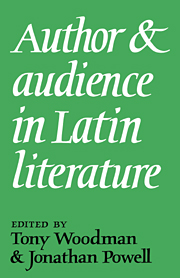Book contents
- Frontmatter
- Contents
- List of contributors
- Prologue
- 1 THE ORATOR AND THE READER: Manipulation and response in Cicero's Fifth Verrine
- 2 STRATAGEMS OF VANITY: Cicero, Ad familiares 5.12 and Pliny's letters
- 3 ‘SHALL I COMPARE THEE…?’: Catullus 68B and the limits of analogy
- 4 ATOMS AND ELEPHANTS: Lucretius 2.522–40
- 5 IN MEMORIAM GALLI: Propertius 1.21
- 6 THE POWER OF IMPLICATION: Horace's invitation to Maecenas (Odes 1.20)
- 7 THE VOICE OF VIRGIL: The pageant of Rome in Aeneid 6
- 8 FROM ORPHEUS TO ASS'S EARS: Ovid, Metamorphoses 10.1–11.193
- 9 POET AND AUDIENCE IN SENECAN TRAGEDY: Phaedra 358–430
- 10 PERSIUS' FIRST SATIRE: A re-examination
- 11 NERO'S ALIEN CAPITAL: Tacitus as paradoxographer (Annals 15.36–7)
- 12 AMOR CLERICALIS
- 13 EPILOGUE
- Notes
- Abbreviations and bibliography
- Indexes
3 - ‘SHALL I COMPARE THEE…?’: Catullus 68B and the limits of analogy
Published online by Cambridge University Press: 13 March 2010
- Frontmatter
- Contents
- List of contributors
- Prologue
- 1 THE ORATOR AND THE READER: Manipulation and response in Cicero's Fifth Verrine
- 2 STRATAGEMS OF VANITY: Cicero, Ad familiares 5.12 and Pliny's letters
- 3 ‘SHALL I COMPARE THEE…?’: Catullus 68B and the limits of analogy
- 4 ATOMS AND ELEPHANTS: Lucretius 2.522–40
- 5 IN MEMORIAM GALLI: Propertius 1.21
- 6 THE POWER OF IMPLICATION: Horace's invitation to Maecenas (Odes 1.20)
- 7 THE VOICE OF VIRGIL: The pageant of Rome in Aeneid 6
- 8 FROM ORPHEUS TO ASS'S EARS: Ovid, Metamorphoses 10.1–11.193
- 9 POET AND AUDIENCE IN SENECAN TRAGEDY: Phaedra 358–430
- 10 PERSIUS' FIRST SATIRE: A re-examination
- 11 NERO'S ALIEN CAPITAL: Tacitus as paradoxographer (Annals 15.36–7)
- 12 AMOR CLERICALIS
- 13 EPILOGUE
- Notes
- Abbreviations and bibliography
- Indexes
Summary
‘Probably the most extraordinary poem in Latin,’ as Lyne describes it, this audacious piece of brilliance has attracted legions of critics. Here no attempt will be made to address each contested individual issue in the hallowed catalogue of notorious problems contained in the scholarly register on ‘Catullus 68’; nor will I chase the chimaera of a ‘full’ reading. Rather, I propose to adopt a partial and oblique approach to this most oblique of poems, taking as my lead the obliquity embodied in the poem's most striking technical feature, obsessively deployed throughout – the simile.
Similes, and the wider system of analogy-making of which they are the most overt example, saturate this poem. One may, in the first instance, refer the main example of the figure, the comparison between the beloved and Laodamia, to the analogical form of much Roman lovepoetry, in which one sees a compulsive mapping of lover and beloved onto the famous pairs of the (mythical or historical) past: Propertius and Cynthia become Milanion and Atalanta (1.1.9–16); they become Varro and Leucadia, Catullus and Lesbia, Calvus and Quintilia, Gallus and Lycoris (2.34.85–94), Paris and Helen (2.15.13–14). Commonly only the beloved is thus analogised (with the reader often being prompted to fill in the missing half of the equation): Cynthia is Ariadne or Andromeda (1.3.1–4); Ovid's Corinna is Semiramis and Lais (Amores 1.5.11–12), she is Helen, Leda, Amymone (Amoves 1.10.1–8). Such exempla have more in common with the figure of simile than may at first appear; they are themselves often classed with similes under the general heading of comparison by the ancient critics.
- Type
- Chapter
- Information
- Author and Audience in Latin Literature , pp. 33 - 44Publisher: Cambridge University PressPrint publication year: 1992
- 11
- Cited by



